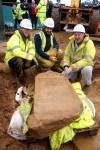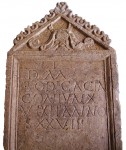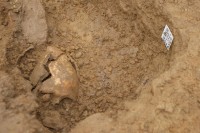 The excavation of the site of the former Bridges Garage in Cirencester has unearthed a wealth of Roman funerary material from 75 graves, including pottery, jewelry and an extremely great chicken. Now Cotswold Archaeology (CA) has made another rare find: a tombstone with an inscription naming the deceased that may be covering her grave. Roman gravestones are rare — less than 300 inscribed ones have been found in the UK, 10 in Cirencester — but this one is in very fine condition, with the pediment atop the stone unbroken and the inscription is still sharp and complete.
The excavation of the site of the former Bridges Garage in Cirencester has unearthed a wealth of Roman funerary material from 75 graves, including pottery, jewelry and an extremely great chicken. Now Cotswold Archaeology (CA) has made another rare find: a tombstone with an inscription naming the deceased that may be covering her grave. Roman gravestones are rare — less than 300 inscribed ones have been found in the UK, 10 in Cirencester — but this one is in very fine condition, with the pediment atop the stone unbroken and the inscription is still sharp and complete.
 The inscription is five lines long and reads: “DM BODICACIA CONIUNX VIXIT ANNO S XXVII.” DM is an abbreviation for Dis Manibus, literally “to the spirits of the dead,” a frequently used dedication on tombstones, so the full inscription translates to “To the spirits of the dead, Bodicacia, wife, lived 27 years.” It only fills the top half of the stone and there are horizontal lines on the bottom half that suggest it would be filled in with another inscription at a later date, perhaps when the husband died, but then it never happened. The tomstone is made out of Cotswold limestone and is elaborately decorated and impeccably carved. Bodicacia’s husband must have been quite well off to be able to afford such an expensive piece.
The inscription is five lines long and reads: “DM BODICACIA CONIUNX VIXIT ANNO S XXVII.” DM is an abbreviation for Dis Manibus, literally “to the spirits of the dead,” a frequently used dedication on tombstones, so the full inscription translates to “To the spirits of the dead, Bodicacia, wife, lived 27 years.” It only fills the top half of the stone and there are horizontal lines on the bottom half that suggest it would be filled in with another inscription at a later date, perhaps when the husband died, but then it never happened. The tomstone is made out of Cotswold limestone and is elaborately decorated and impeccably carved. Bodicacia’s husband must have been quite well off to be able to afford such an expensive piece.
The Cotswold Archaeology team has been digging since January as a precursor to the construction of an addition to the St James Place Wealth Management structure that was built on the Bridges Garage site. They’ve discovered a total of 55 graves and were almost finished with the excavation when they found the tombstone.
“The problem we had was how to lift the stone without damaging the burial underneath. We could already see the skull and the rest of the body were covered by only a thin layer of soil,” [said Cliff Bateman, the Project Manager.]
“We decided to dig a hole next to the grave and then gently roll the stone over onto a pallet set within the hole. This could then be lifted out by a crane and transported to a secure store.”
Cotswold Archaeology has a short timelapse video of the lifting of the headstone here, and since the BBC filmed the event and broadcast it live, its article has two videos, one of the lifting of the stone, and one interview with CA archaeologist Neil Holbrook after the stone was turned over to reveal the inscription.
What makes this discovery all the more remarkable is that the tombstone survived at all. First it remained intact and virtually undamaged when it fell on top of the grave. Then it had to survive the stone foragers who looted graves and buildings to use as masonry for new construction. Archaeologists think that the headstone fell over relatively soon after it was installed and then was covered by soil so later looters missed it.
Then it had to outwit modern development. Before the Bridges Garage was built in the 1960s, the site was excavated by archaeologist Richard Reece who found 52 burials and an engraved headstone (not connected to any human remains). Then a building was constructed and an area large and deep enough to accommodate two huge underground fuel tanks was dug up, so archaeologists didn’t expect to find much of anything intact when they surveyed the site in 2011 before new construction. Instead they found an extensive burial ground with intact artifacts and human remains. The tombstone and the fragile human remains just under it came within inches of destruction.
CA’s Chief Executive Neil Holbrook said it was amazing the tombstone had survived “When they built the garage in the 1960s they scraped across the top of the stone to put a beam in. If they’d gone a couple of inches lower they’d have smashed it to smithereens.”
 The stone dates to 100-200 A.D. It was found on top of adult human remains and next to the remains of three very young children. This could very well be Bodicacia and her children buried in a family grave. If it does prove to be Bodicacia’s grave, it will be the only of its kind ever found in Britain. Roman gravestones aren’t often found with associated remains; finding one with a name engraved on it which identifies the remains is the kind of thing you find in exceptional preservation conditions like Pompeii.
The stone dates to 100-200 A.D. It was found on top of adult human remains and next to the remains of three very young children. This could very well be Bodicacia and her children buried in a family grave. If it does prove to be Bodicacia’s grave, it will be the only of its kind ever found in Britain. Roman gravestones aren’t often found with associated remains; finding one with a name engraved on it which identifies the remains is the kind of thing you find in exceptional preservation conditions like Pompeii.
Experts will study the tombstone and remains in depth, a process that could take two or so years, in the hopes of answering some of these questions. After that, the stone will be given a permanent home in a museum. The Corinium Museum has been the fortunate recipient of other treasures unearthed at the Bridges Garage excavations — the cockerel is on display there now — so they’re hoping they’ll get Bodicacia’s headstone as well.
Seems to me there’s an assumption being made that this is THE Boudica, Queen of the Iceni, who died in AD 60 or 61–40 years before the earliest date assigned to the manufacture of the gravestone. And is it reasonable to assume that no other British woman was named Boudica (or Bodica) after the famous one died? And why would the Romans put up a gravestone to a woman they looked on as a savage (as do I) because of the brutality of her rebellion? Britannia was almost lost as a Roman province because of her, and other parts of the Empire would have risen up once they saw that rebellions could work.
Seems as if we need to welcome Bodicacia (i.e. Boudica, one of her daughters or maybe someone completely different) to the ‘Club XXVII’. Other ‘parts of the Empire’, by the way, had risen up earlier -not without success- and over 20,000 were annihilated. In this case, contrastingly, the ‘savages’ seem to have had money issues (‘divide et impera’?).
As Cassius Dio in his Roman History (LXII; 2) puts it:
‘An excuse for the war was found in the confiscation of the sums of money that Claudius had given to the foremost Britons; for these sums, as Decianus Catus, the procurator of the island, maintained, were to be paid back. This was one reason for the uprising; another was found in the fact that Seneca, in the hope of receiving a good rate of interest, had lent to the islanders 40,000,000 sesterces that they did not want, and had afterwards called in this loan all at once and had resorted to severe measures in exacting it. But the person who was chiefly instrumental in rousing the natives and persuading them to fight the Romans, the person who was thought worthy to be their leader and who directed the conduct of the entire war, was Buduica, a Briton woman of …’
Hey guys,
Check out my latest article on Sparta.
Kingofthewild.org
what happens to the human remains? Are they re-buried there?
What happens to the human remains they found?
I don’t understand why the gravemarker should go to a museum. If it was covering a grave and there were bones found underneath it what about a little respect for the dead. The bones should be reburied some where else with the gravemarker over it. Just because it is ancient doesn’t mean it belongs to the public. I am very interested in history and archealogy, but here I think the line is being crossed.
I completely disagree.
It is nowhere stated, or implied, that the remains were of THE Boudica but simply memorialized a woman of that name. That’s exactly what the monument did.
You say, “And is it reasonable to assume that no other British woman was named Boudica…” Well, here’s a monument to one.
Also, mention was made that the accompanying remains were of “small” children. Acto the story, Boudica’s daughters (2…not 3) were old enough to be raped and are universally depicted as pre-teens or young teenagers…hardly “small”. It is nowhere mentioned that Boudica had other, younger children, AFAIK.
As for the rest, I think it’s a pity that the rebellion wasn’t “brutal” enough to actually succeed. The Romans had evolved brutality into an art form and I rather enjoyed the idea that they got some of their own back.
I’m sure that the image of Boudica exhorting her troops from a chariot while her long, red hair streamed back from her face is pure artistic license, but it is still an image I find very, very pleasing.